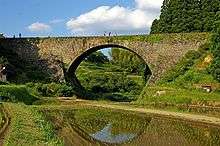Tsūjun Bridge


Tsūjun Bridge (通潤橋 -kyō) is an aqueduct in Yamato, Kumamoto, Japan. It is an arch bridge completed in 1854 and is 84.0m long. The arch spans 27.3m. It is the largest stone aqueduct in Japan.[1]
The Japanese Agency for Cultural Affairs has designated the bridge an Important Cultural Property.[1]
History and Technology
This bridge proves the high level of stone bridge technology at the time it was built. Yasunosuke Futa (1801–1873), who was the head of the then Yabe village, planned and after funding, with the help of the group of 41 stone technicians and many farmers, succeeded in building the bridge in 1854. Its purpose was to let water flow into a higher area (Shiroito Plateau) for farming. After placing wooden frames, stones were placed on the frames, and three stone aqueducts were made. After that, the wooden frames were removed. Because the aqueducts were lower than the upper part of the waterway by 6 meters, a reversed siphon mechanism works when man lets water flow through the aqueducts. The stone aqueducts were made watertight with mortar. The bridge was completed in 1854. In order to keep the aqueducts in a perfect condition, water is poured into the river once in a while.
References
External links
See also
| Wikimedia Commons has media related to Tsujun Bridge. |
Coordinates: 32°40′54″N 130°59′38″E / 32.68167°N 130.99389°E